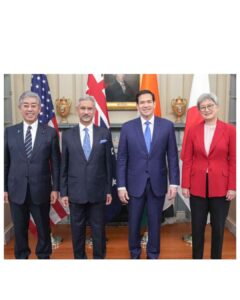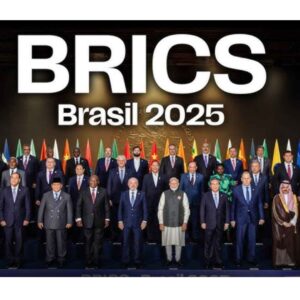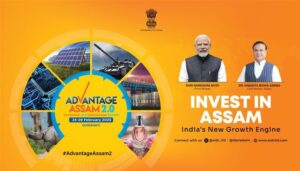
Introduction
The 17th BRICS Summit 2025, hosted from July 6–7, 2025, in Rio de Janeiro, Brazil, convened leaders from the bloc’s core members—Brazil, Russia, India, China, and South Africa—alongside the expanded group of new full members and partners, including Indonesia, Iran, UAE, Egypt, Ethiopia, Belarus, Bolivia, Kazakhstan, Cuba, Nigeria, Malaysia, Thailand, Vietnam, Uganda, and Uzbekistan.
The summit focused on “Strengthening Global-South Cooperation for a More Inclusive and Sustainable Governance,” emphasizing solidarity, democratic cooperation, and reforming multilateral organizations.
Under President Luiz Inácio Lula da Silva’s chairmanship, Brazil aimed to position BRICS as the spiritual heir to the Cold War-era Non-Aligned Movement, advocating for stronger representation of the Global South while navigating global trade tensions.
The summit’s Joint Declaration pledged support for climate finance frameworks, AI governance, health cooperation, and the establishment of new environmentally focused funds, such as the Tropical Forests Forever Facility.
However, the event drew further international attention. Absent from Rio were China’s President Xi and Russia’s President Putin, who attended electronically amid geopolitical problems.
Meanwhile, U.S. President Donald Trump threatened 10% tariffs on any nation seen as aligning with “anti‑American policies” linked to BRICS, escalating economic tensions.
Despite external challenges, the bloc reaffirmed its commitment to exploring a cross-border payment system, also known as BRICS Pay, to reduce dollar dependency and promote financial independence.
Highlights of the 17th BRICS Summit
- The summit adopted the “Rio de Janeiro Declaration”, titled “Strengthening Global‑South Cooperation for a More Inclusive and Sustainable Governance,” featuring 126 distinct commitments across politics, security, economy, health, AI governance, and climate action.
- Discussions centred on three pillars:
(i) Political and security cooperation
(ii) Economic and financial coordination
(iii) Cultural engagement and people-to-people links
- Indonesia joined as the first Southeast Asian full member, alongside 11 partner nations, including Egypt, Iran, and Nigeria, strengthening BRICS’s claim to represent more than 50% of the global population and 35-40% of global GDP.
- BRICS reaffirmed their commitment to deepening multilateralism, promoting UN, IMF, and World Bank reforms, and advocating for permanent Security Council seats for Brazil and India, with eventual participation reflecting Africa’s interests.
- Member leaders asked that developed nations provide fresh, supplementary, grant-based climate finance, distinct from ordinary development aid, to assist poorer countries in emissions reduction and climate resilience.
- Brazil positioned itself as a bridge between global climate politics and emerging economies, capitalizing on the momentum building up to the UN Climate Summit (COP30) in Belém later in 2025.
- For the first time, BRICS published a standalone statement on Global Governance of Artificial Intelligence, pushing for more inclusive, equitable, and geographically representative frameworks in international AI regulation.
- Launch of the BRICS Partnership for the Elimination of Socially Determined Diseases, which aligns with member nations’ broader goals of poverty reduction, hunger relief, and public health collaboration.
- Leaders re‑committed to exploring a cross-border payment infrastructure, BRICS Pay, aimed at facilitating transactions in local currencies and reducing reliance on the U.S. dollar and SWIFT system.
- The summit strongly condemned the United States’ unilateral tariff policies and its military operations in Iran, Gaza, and Ukraine, urging adherence to international law, condemning increasing protectionism, and emphasizing the necessity for a multipolar world order.
- Brazilian President Lula rejected Donald Trump’s threats of an additional 10% tariff on BRICS-aligned countries, calling it “very mistaken” and declaring, “We don’t want an emperor,” signalling BRICS’s intent to chart an autonomous economic path.
India’s Participation and Position at the 17th BRICS Summit
- Prime Minister Narendra Modi became the first Indian head of government to visit Brazil in nearly six decades, cantering his tour on the Rio Summit and bilateral meetings in Brasilia, including with the leaders of Cuba, Malaysia, South Africa, and Vietnam.
- Prime Minister Modi emphasized peace, multilateral reforms, the fight against terrorism, and the responsible application of artificial intelligence as critical global issues during his BRICS plenary address.
- India’s position on terrorism was clearly incorporated into the joint declaration, which denounced the Pahalgam attack in Kashmir “in the strongest terms” and called for sanctions on those who finance or shelter terrorists, indicating India’s diplomatic success in achieving a unified BRICS stance on zero tolerance.
- PM Modi emphasized that the BRICS must set an example by reforming bodies such as the UN Security Council, IMF, World Bank, and WTO to reflect 21st-century realities. He criticized the “double standards” that the Global South faces in terms of development, climate, and trade.
- He also advocated rebranding BRICS under India’s forthcoming presidency in 2026 as “Building Resilience and Innovation for Cooperation and Sustainability,” with a focus on a people-centered agenda.
- India underlined its leadership in Digital Public Infrastructure with initiatives like Digital India, IndiaAI, and One Nation, One Subscription. It invited BRICS partners to an “AI Impact Summit” to be hosted in India, reinforcing its push for responsible AI governance and transparency in digital content authenticity.
- Prime Minister Modi emphasized equal access to agricultural biotechnology and climate adaptation, proposing that the BRICS Agricultural Research Platform serve as a shared platform for the Global South, together with a new BRICS scientific and research archive.
- India urged the dismantling of intra‑bloc export controls to enhance trade and economic solidarity across BRICS members.
- He also stressed the New Development Bank’s need for demand-driven funding, long-term financial stability, and sound credit ratings, implying that stronger internal systems would provide legitimacy to India’s aspirations for global change.
- In environment and health sessions, Modi positioned climate justice as a moral duty and stressed the need for affordable technology transfer and financing. He highlighted initiatives such as Mission LiFE, the International Solar Alliance, Coalition for Disaster‑Resilient Infrastructure, and Green Hydrogen partnerships, and reaffirmed India’s leadership in expanding global health access through Ayushman Bharat.
India’s active diplomacy and strategic leadership at the summit affirmed its vision of BRICS as a credible, diverse, and reformist bloc. By aligning its domestic flagship models with global cooperation goals, India firmly positioned itself at the centre of BRICS’s future trajectory under its forthcoming presidency.
Conclusion
The 17th BRICS Summit 2025 in Rio de Janeiro represented a watershed moment in the bloc’s history, transitioning from a loose coalition of developing economies to a more structured, forceful platform for global South leadership. The summit, hosted under Brazil’s calm and strategic supervision, highlighted both the bloc’s expanding ambitions and the challenges that lie ahead.
The expansion in membership, the push for reforms in global governance institutions, and concrete steps toward financial autonomy—such as the BRICS Pay initiative and the launch of a multilateral guarantee fund—signaled a maturing alliance. India’s proactive engagement on climate finance, AI governance, and multilateral reform positioned it as a key architect of the bloc’s future, while Brazil’s role as host reflected its diplomatic finesse and renewed relevance in shaping international discourse.
Despite the absence of Presidents Xi and Putin, the summit was successful in developing a strong joint declaration and pursuing a shared Global South agenda. However, internal divergences, overlapping geostrategic affiliations, and diverse economic models continue to undermine BRICS’s cohesion as a single geopolitical force.
Finally, the Rio Summit reiterated the BRICS’ shared desire to challenge the dominance of old Western-led institutions and create a more equitable, inclusive global order. As India prepares to assume the BRICS presidency in 2026, the group’s capacity to retain momentum, keep commitments, and manage its growing diversity will be the ultimate litmus test of its future relevance.






